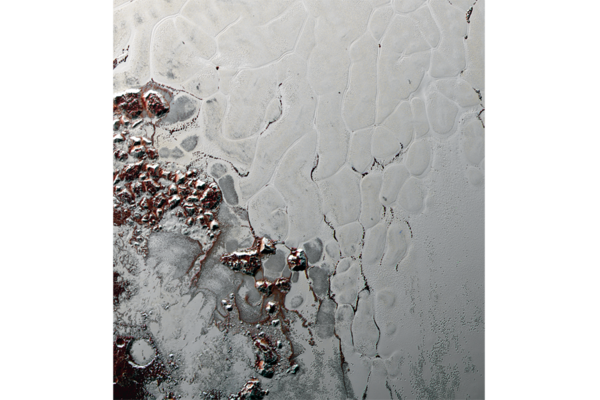Pluto’s distinctive heart-shaped feature may appear still, but it’s actually made up of churning icy cells, scientists say.
Pluto’s bright “heart” captivated astronomers and amateurs alike when NASA’s New Horizons spacecraft beamed back the first clear images of the dwarf planet last July. But there’s more to that distinctive shape than meets the eye.
In particular, the left lobe of the heart-shaped feature, informally dubbed Sputnik Planum, appears unusually smooth and plain at a glance. But when scientists took a closer look, they spotted a strange rubbly pattern across the expanse.
Interlocking polygons appear to be etched into the surface of Sputnik Planum, slightly elevated in their centers, making the bright plain look as if snakeskin had been stretched across it.
“It was such an unusual pattern to see at such a large scale,” says William McKinnon, a co-investigator on the New Horizons team and researcher at Washington University in St. Louis.
What’s behind these strange shapes?
It turns out this part of Pluto’s “heart” is actually a sort of cosmic lava lamp, according to models described in two different papers published Wednesday in the journal Nature. And the feature continues to churn, resurfacing the region on geologically short timescales.
Sputnik Planum is covered with a sheet of nitrogen ice. Heat produced by radioactivity in the rocky interior of Pluto causes the nitrogen at the bottom of this icy layer to expand, making it more buoyant. That heated nitrogen ice begins to rise.
Once it has risen, the nitrogen ice begins to cool and sink back down. This cycle, called convection, forms cells.
“All of these individual blobs you see in these pictures are the rising tops of these convection cells,” Dr. McKinnon, lead author of one of the new studies, tells The Christian Science Monitor. “It’s basically like a giant lava lamp.”
And “not only is this material convecting,” says Alexander Trowbridge, lead author of the other study, but “it’s convecting vigorously.”
In fact this process churns so rapidly that Pluto’s heart gets a full face-lift every 500,000 to 1 million years or so. “It’s solid material in motion,” McKinnon says.
This process could explain why Sputnik Planum is so remarkably smooth. “The whole ice sheet has not a single crater on it,” Mr. Trowbridge, a PhD student at Purdue University, tells the Monitor.
“Crater counting in planetary science is used to determine the ages of surfaces,” Trowbridge says. A surface that isn’t pockmarked with impact craters means it hasn’t been around very long to be hit by space rocks.
“Because there are no craters in this area, it puts a maximum age at 10 million years for this surface, which is incredibly young for the surface of Pluto,” Trowbridge says.
And convection makes the smoothness of Pluto’s heart less mysterious, says Geoffrey Collins, a planetary geologist at Wheaton College in Norton, Mass. who was not part of either study. “If you have this convective process, you can erase the impact craters continuously,” he tells the Monitor.
Cracking the case on convection
Scientists have been abuzz about the strange cellular structures appearing on Sputnik Planum “ever since those first pictures came back last summer,” Dr. Collins says.
“Convection popped up as one of the first explanations,” he says, but it wasn’t the only one. Some suggested that the surface could have cracked under temperature pressures, or perhaps ice wedging could explain the odd polygons.
“But none of those really work in a big nitrogen-ice dominated basin,” Collins says. So when the spectrometer data from New Horizons confirmed that Sputnik Planum is filled with nitrogen ice, the convection model “seemed to fit.”
Now McKinnon and colleagues have created a computer simulation of how that process works. And both teams calculated the Rayleigh number, a parameter associated with buoyancy-driven flow that determines whether heat travels through a material by way of convection or conduction.
Trowbridge and his team also ruled out any sort of brittle cracking, as it wouldn’t resurface Pluto’s heart on the timescales necessary to make it so smooth.
Both teams confirm that convection explains Pluto’s polygons.
“These two papers are written by two completely different sets of people. One of whom is deeply involved in the New Horizons team and the other is a group that’s outside the team,” Collins says. “If you wanted to have some kind of scientific fight, that’s the perfect set up. And yet the two groups reach essentially the same conclusion.”
Taking the pulse of Pluto
Discovering dynamic processes like convection on the icy surface of Pluto “validates why you send these missions in the first place,” Trowbridge says of the New Horizons mission, of which he was not affiliated. “They’re writing the book on Pluto right now.”
And these discoveries display “the richness and variety of nature,” McKinnon says.
“We can fly to the edge of the solar system,” he says. “We can fly past Neptune to a distant, small planet, and instead of finding a cold, dead world covered in craters, we find this wildly active place.”
Source: Christian Science Monitor

































Leave a Comment
You must be logged in to post a comment.